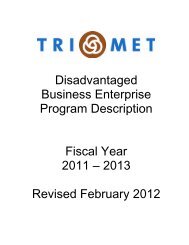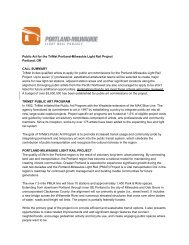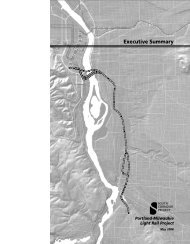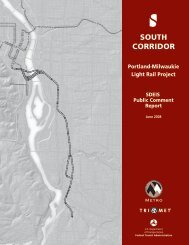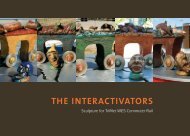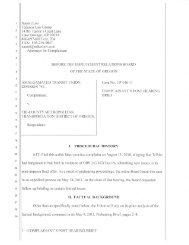January 19 meeting notes - TriMet
January 19 meeting notes - TriMet
January 19 meeting notes - TriMet
- No tags were found...
You also want an ePaper? Increase the reach of your titles
YUMPU automatically turns print PDFs into web optimized ePapers that Google loves.
Citizen’s Advisory Committee (CAC)Thursday, <strong>January</strong> <strong>19</strong>, 2012Former Advantis Credit Union Building3717 SE 17th AvenuePMLR CAC Members PresentBarbara Andersen, Oak GroveDavid Aschenbrenner, Hector Campbell NeighborhoodLina Bensel, Independent Living ResourcesRay Bryan, Historic Milwaukie NeighborhoodPaul Carlson, Oregon Museum of Science & Industry (OMSI)Valerie Chapman, Oak GroveDavid Edwards, Oak GroveCatherine Goode, Ardenwald-Johnson Creek NeighborhoodNeil Hankerson, Milwaukie Downtown BusinessGreg Hemer, Milwaukie LumberErin Kelley, Bicycle & Pedestrian AdvocateAdam Marx, Brooklyn Action CorpsCindy Miguel, Island Station NeighborhoodFred Nelligan, Oak Lodge Community CouncilFred Nolke, Eastmoreland NeighborhoodSusan Pearce, Hosford Abernethy Neighborhood (HAND)Teri Pucik, SMILEJeff Reaves, Central Eastside Industrial Council (CEIC)Valeria Ramirez, Portland OperaDee Walsh, REACHRick Williams – CHAIR, Lloyd District Transportation Management AssociationPMLR CAC Members AbsentKen Love, South Portland NeighborhoodArnold Panitch, <strong>TriMet</strong> Committee on Accessible Transportation (CAT)Dan Zalkow, Portland – Portland State University (PSU)Rick Williams (CAC Chair) welcomed attendees and opened the <strong>meeting</strong>. There wereno comments on the previous <strong>meeting</strong>’s <strong>notes</strong>.Project Finance Update, presented by Rob Barnard, <strong>TriMet</strong> Project DirectorRob reviewed how the project is funded. The <strong>TriMet</strong> portion of the funding will comefrom increased payroll tax revenues that were authorized in 2009 to fund new service.This new service leverages the whole transit system, since light rail provides the most1
cost-effective way to add service. The operating cost of light rail is $1.89 per boardingvs. $3.65 for bus service.<strong>TriMet</strong>’s share of the project is about 4 percent. Half the rest comes from the federalgovernment. As discretionary funds, the federal share can go anywhere in the nation,but we'd rather have them here to provide local jobs.The City of Milwaukie and Clackamas County have also made funding commitments tothe project, which <strong>TriMet</strong> views as legally binding contracts. Recently petitions werefiled by some citizens opposed to those contracts. Meanwhile the project has beenmoving forward. Based on good-faith reliance on those contracts, <strong>TriMet</strong> has spent$<strong>19</strong>3 million to date and has contracts committed for $340 million. In terms ofconstruction jobs, 285 people are now working on the project. There are 172 firmsunder contract. The current jobs total over 1,000 when you add professional servicessuch as engineers.Regarding the federal funds, Congress passed a minibus bill to fund transportation.There has been $511 million set aside for new Full Funding Grant Agreements (FFGAs)for projects such as the Portland Milwaukie Light Rail Transit Project (PMLR). PMLR isone of five FFGAs soon to be awarded nationwide. Last week, when Peter Rogoff,Administrator of the Federal Transit Administration (FTA), was in town, he announcedpublicly that the “money was on its way.”There are just a few more steps to finalizing the FFGA. The project managementoversight and financial consultants have finished their reviews. FTA staff has finishedthe wording of the FFGA. That has all been combined and is now being reviewed byFTA management, which should be completed by the end of <strong>January</strong>. It will then moveto the Office of the Secretary and the Office of Management and Budget for one-monthreview, then to Congress for a 60-day notice period, with signing expected in May. Thismeans some funds will arrive in 2012, a year earlier than expected.QUESTIONSErin Kelley: Can you start some construction sooner?Rob Barnard: We already have work under way. This (earlier funding) helps our cashposition.Valerie Chapman: How many jobs will be created?Rob Barnard: We project the project will create more than 14,000 jobs total, about halfdirect and half indirect. Visit the <strong>TriMet</strong> website soon for details.Catherine Goode: How many jobs will be filled by people in the Portland region?2
Rob Barnard: The website will detail this. You can see a map and list of all 172contractors and subcontractors, their names, addresses, disadvantaged status andmore. We are committed to hiring disadvantaged, small and local firms.David Aschenbrenner: Does earlier funding lower our interest payments?Rob Barnard: The cash flow through the last payment in 2020 is our best guess. It’s abit early to spend that money. But it does show a strong commitment from federalgovernment and solid support. It is encouraging to see that the federal governmentfunded the program for next year. And by getting a portion of those funds, it shows ourproject is well-received and supported.Paul Carlson: Have you received any bids for major expenditures?Rob Barnard: We should have them by the end of month.Construction Updates – west segment and bridge, presented by Rob Barnard,<strong>TriMet</strong> Project DirectorRob highlighted construction progress on SWt Lincoln Street, the Harbor structure, andthe PMLR bridge. He also showed a BridgeView video interview segment on bridgetower construction (videos online at trimet.org/pm/construction/bridgeview). We will startto see the piers rise out of the water this spring, with tower construction to follow.Design and Construction Updates – east segment, presented by Leah Robbins,<strong>TriMet</strong> east segment directorLeah updated the committee on east segment construction progress. She highlightedwork at the following locations:Clinton to river multi-use pathPowell and HolgateCrystal Springs Creek crossingTacoma site /Johnson Creek stationMilwaukieKellogg structure and Trolley Trail constructionPark AvenueQUESTIONSCindy Miguel: Question about existing pedestrian bridges.Leah Robbins: The SE Gideon/16th/Brooklyn structure will be removed in 2013 inconnection with track construction. The SE Lafayette structure, owned and maintained3
y Union Pacific Railroad (UPRR), will remain. However, the city is requiring itsreconstruction when UPRR implements its Brooklyn Yard modernization plan.Dee Walsh: How long will construction on SE 11th and 12th avenues continue?Leah Robbins: Some of the work going on now is private utility work, in preparation forlight rail construction, but there is also a City of Portland sewer project. While we cannotdirect the private utilities, we are coordinating with them, as well as with the City sewerproject.Valerie Chapman: When will work occur at Park Avenue? And when will the treescome down?Leah Robbins: Utility work will start later this year. Regarding the trees, federal lawprotects migratory birds, and discourages tree removal from March through August,when they are more likely to be nesting. This has bearing on our work on the Kelloggstructure. Trees will be removed at the south abutment of the structure by March 2012.Most of the other trees along the Trolley Trail portion of the alignment will remain untilSeptember 2012. (In a handful of other locations where the project schedule requirestrees to be removed during the March to August window, a federal biologist is oncontract to monitor and discourage nesting by any migratory birds in these trees.)Greg Hemer: When will land acquisitions take place?Leah Robbins: The acquisitions are coordinated with the construction schedule. Mostare already in progress.Catherine Goode: Was the commercial proposal for the Tacoma station area rejected?Leah Robbins: The developer’s revised proposal didn’t meet <strong>TriMet</strong>’s criteria forunsolicited proposals. We are in the process of acquiring that land.Fred Nelligan: What is the timeline or phasing for demolishing buildings after they areacquired?Leah Robbins: We are working to make that a seamless process from permit applicationto approval. The timeline is based on the permit and the demands of the particularproperty.Barbara Andersen: Is there any hope for a parking structure being built at the TacomaStreet station? I’m concerned that if we build only surface parking, we’ll never get astructure in there. Can something be built now to accommodate a later structure? Iwould like to see some creative thinking about how to increase the size of this parkingstructure later. A surface parking lot will be obsolete almost as soon as it’s built.Leah Robbins: There is a possibility, but it’s low.4
David Aschenbrenner: Are you aggressively recycling demolition materials?Leah Robbins: The demo contract project manager includes scoping recycling into eachbuilding as a part of the contract. Some buildings have more potential than others.Catherine Goode: Is there a priority given to certain add-backs, such as the Bybeepullout, based on criteria such as safety and neighborhood concerns?Leah Robbins: At the time of recalibration, we didn’t choose add-backs in any priority.Instead, we marked the latest point in the project when items could be brought back forthe same cost figure. The intention was, as we got to levels where we could considerbringing scope back, we would prioritize those elements. In general, all that has beenmoved to later in the process than anticipated.Dee Walsh: The issue is the FTA won’t allow you to spend the contingency until you’refurther down the line, so that pushes back decisions about adding back scope?Leah Robbins: Yes.Audience member: When will this (Advantis) building be demolished?Claudia Steinberg: I believe it's around September.Valerie Chapman: When will the buildings near Park Avenue station be demolished?Leah Robbins: We’re proceeding with demolitions for properties we own as soon aspermits are in place. Each building has its own requirements for demolition, such asremoving hazardous materials.Valerie Chapman: DaVinci’s restaurant has not relocated after it had to leave itsbuilding. Why? Was there a breakdown somewhere?Claudia Steinberg: DaVinci’s owners knew that building would be demolished when theyentered into their lease. There was full disclosure by the previous building owner. Weare still working with the DaVinci’s owner on their next steps. The reason they closedwas related to an issue between them and their landlord.Barbara Andersen: When will construction start behind the Waldorf School? I’ve heardexcavation would start in June this year.Leah Robbins: Utility work is mainly within the cross streets. The earliest that wallconstruction could occur is summer.5
Claudia Steinberg: We are <strong>meeting</strong> with property owners along the alignment. We willshare with you in our next <strong>meeting</strong> the Conduct of Construction. We want a <strong>meeting</strong>with the Waldorf School. Now we are starting a whole new phase.Fred Nelligan: Are any planned 2012 activities contingent on approval of the FFGA?Leah Robbins: No. The near-term schedule is all related to foundations and utilityconstruction. That work will occur after we receive the FFGA but we’re gearing up now.Rob Barnard: We have the authority to procure materials requiring a long lead time,e.g., steel for the Harbor Structure, and to install advance utilities. Three letters of noprejudice allowed advanced construction on the bridge, utilities along the Moody project,and for another structure. We have enough authority to keep the project moving whilewaiting for the FFGA.Greg Hemer: What if you don’t get the FFGA?Rob Barnard: Congress has signed and the president has passed new funding forFFGAs. The administration has said the money is on its way. We’re in the final stages ofthe approval process. All indications are good.Susan Pearce; One of the key contingencies was the switches for the Close the Loopstreetcar project. Will those have to wait until the end of the project? Will that affect thechances of their being installed?Rob Barnard: When we made our FFGA application, we included in our project budgetthe small elements of Close the Loop that are within our track envelope. We took adrawdown on project contingency to make that happen. The City of Portland is seekingfunding for the remaining portions of the Close the Loop project. We’ve advanced thethe design work so the estimate can be updated.Public Involvement Update, presented by Claudia Steinberg, <strong>TriMet</strong> CommunityAffairs ManagerClaudia announced the dates and locations of open houses in southeast Portland,downtown and Milwaukie. We will have information on the designs and the Conduct ofConstruction.At next month's CAC <strong>meeting</strong>, we will present the Conduct of Construction and discussthe construction schedule.The Oak Grove Community Council on Wednesday, Jan. 25 at 7 p.m. will host adiscussion on light rail and crime at Rose Villa senior community. The council hasinvited law enforcement officials from Milwaukie, Clackamas County and <strong>TriMet</strong>. Weencourage people with concerns to attend.6
Claudia asked the committee for feedback on the desirability of the Advantis building asa location for committee <strong>meeting</strong>s. Most members supported it.RoundtableCindy Miguel: My Island Station neighborhood is emotional. We have homes beingvacated. As we see more properties acquired, we’ll see more needs of the heart ratherthan of the head. I’d like to see Claudia and the <strong>TriMet</strong> outreach team work with thepeople left behind as well as with the people displaced. I’d to find a way to turn the tideand make it more positive.Erin Kelly: I’d like to know more about what will be improved around the Umatillaintersection near Tacoma Street station. I’d like to see what <strong>TriMet</strong> is going to do aboutrelocating the bus stop there and making it easier for pedestrians to cross Highway 99.David Aschenbrenner: ODOT may need to come and explain the Umatilla-Tacomaproject scheduled for this spring and summer.Teri Pucik: I’d like more information on the Crystal Springs culvert. We’ve had floodingthere before. The presentation slides didn’t make the new culvert appear any wider,only longer.Leah Robbins: The city and <strong>TriMet</strong> are designing this culvert. All natural resourcesagencies are reviewing this project in detail. It will have to pass criteria for hydrologyand habitat.Lina Bensel: I’m still concerned that certain streets and intersections will be closed totraffic for seven days at a time. I would like to know more about that and how toameliorate that.Catherine Goode: I’d like to think that our tour of the Tacoma Street area in Octobermay have helped nudge ODOT to make some improvements. They painted the islandvivid yellow and reinstalled the pedestrian crossing sign, which had once again beenknocked down.Fred Nelligan: At the south end of the alignment there are a couple of voter initiativesbeing kicked off this week that are basically anti-rail. City of Milwaukie has beenstruggling with a white oak tree in Kronberg Park. <strong>TriMet</strong> and Milwaukie have reachedagreement on a process for working to save the tree. These kinds of discussions got methinking of the big picture. We as a citizens committee may want to draft a letter to thePMLR Steering Committee and copied to Clackamas County Commission, City ofMilwaukie, Portland City Council and Portland mayor saying that we want to shareequally in the wealth and also expect all communities to share equally in cuts and addbacks.7
Cindy Miguel and I attended a <strong>meeting</strong> in Oak Grove where 250-300 people gathered inopposition to light rail. Speakers overall stood opposed to mass transit, light rail orchange. The <strong>meeting</strong>’s focus was to pressure the county commission about its $25million commitment to the project. They're thinking that if they can jeopardize the $25million, it would also jeopardize the federal government’s 50 percent match. But in OakGrove, which I represent, the people leading the community forward are counting onthis light rail project to be a catalyst. There’s a lot of work to do still.Rick Williams: Perhaps we can discuss these (Clackamas) proposals at our February<strong>meeting</strong>. We could come to our own conclusions about what we can do. We appreciateCindy and Fred for going.Greg Hemer: I know a lot of these people who are opposed to light rail. I encouragethem to volunteer. My point to them is, where were you in 2006 and 2007 when all thesedecisions were being made? Join some of these committees and become a part of thecommunity and a part of the solution. I encourage everyone, pro or con, to volunteer.I’ve learned a lot throughout this process. Everybody’s opinion is valid. I encouragethem to join the committees that form when these processes start.On the abandoned buildings, consider connecting with the Portland Rebuilding Center,firefighters and Metro’s used materials website.I appreciate the environmental practices, such as green roofs, solar panels and stormwater cisterns.Barbara Andersen: Is there an update on art at Park Avenue?Ann Becklund: It’s in process still. They expect to select a new artist around March.Valerie Chapman: There is a sense from opponents to the project that there has beenno involvement. It may be helpful for people to understand how many hours of citizentime already have been put into this project.Cindy Miguel: That’s why it’s important to reach some of the people who I talked aboutearlier. Get them on committees and get them involved.Rick Williams: If there are better ways to communicate to residents, let us know andwe’ll pass that on to the project team. Every time we have done that, they haveresponded.Fred Nelligan: Part of the problem in Clackamas County as far as communication goesis that opponents frame their unhappiness as “no one listens to me.” Personally, Ibelieve the powers that be, our elected officials, are listening. But when the decisionsdon’t fit their views, they think they’re not being heard. But this is representativegovernment. It’s the cumulative voice that should prevail.8
Catherine Goode: Is this opposition new or has it been simmering for a while?Fred Nelligan: It’s been simmering for a while, but this group was successful inNovember on their ballot initiative regarding urban renewal. That success emboldenedthem. They’re well organized. Now their focus is to force future rail projects to acountywide vote.Public CommentDavid Rowe: I once owned a house one block from here but have always beeninterested in the project. On the bridge, will light rail and street car run on the sametrack?Rob Barnard: Yes, they’re designed to share the same track.David Rowe: There was a lot of pushback when MAX first was proposed. Governorcandidate Norma Paulus said the best thing would be for someone to take the keys andsteal it. They called it WPPS on Wheels. And yet, on opening day, more than 150,000people showed up to ride the trains.Michael Aiello, homeowner. I own a home about four blocks away. Thank you for yourhard work. As a resident, I’m acutely aware of the drawback of the impassable nature ofthe rail line and Powell Boulevard. I applaud attempts to take away blind turns. Thisneighborhood is so close to everything yet still so cut off. ODOT has been kind butunmovable. Union Pacific is trying to close rail crossings. Has there ever beendiscussion about rail crossings at ground level, particularly here on SE 17th Avenue andacross to Hosford Abernethy?Leah Robbins: We had multiple conversations early on about these issues. Right now,it’s not possible to add rail crossings at grade.Peter from Sellwood. I am concerned with the Tacoma station. It seems MAX isproposed to run along a large dead space against a backdrop of a neighborhood that isalready minimally served. It’s on the other side of the freeway from the neighborhood itwill serve. If I can't drive to the station and count on parking, it’s absolutely useless tome. It seems the line has not been designed well to maximize service in between thetwo end-points.Philip, Brooklyn homeowner. I accept construction and the loss of my left turn. However,we’re already experiencing a lot of disruption from construction workers using our street,taking on-street parking, causing vibration, dust, etc. Has that been addressed in theConduct of Construction?9
Rob Barnard: The public utilities currently at work are not under our control as will beour contractors. We’ll address these kinds of issues under the Conduct of Construction.David Aschenbrenner: One thing about the light rail is how the bus lines areinterconnected with the stations. That is one of the issues I’m dogging from theMilwaukie standpoint: how we can get our citizens down to the stations on bus feederlines with good frequency so they don’t have to park at the station. That’s coming. It’spart of the project.Rick Williams adjourned the <strong>meeting</strong> at 8 p.m.Next CAC <strong>meeting</strong>: Thursday, February 16, 6–7:30 p.m., Former Advantis CreditUnion Building 3717 SE 17th Avenue10




